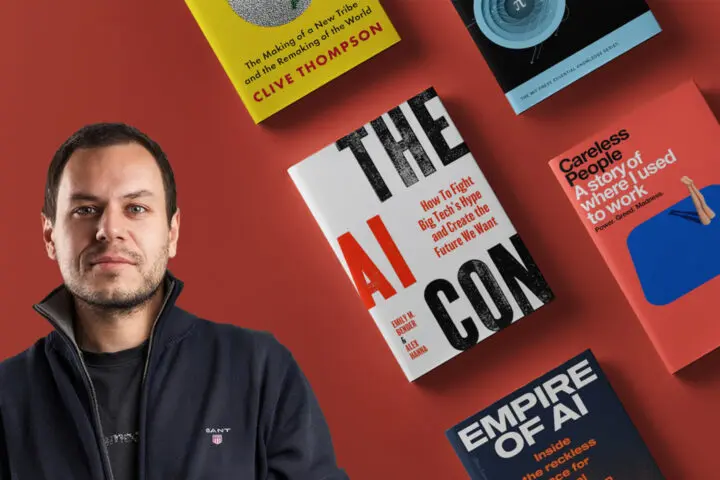Do we really need cryptocurrencies?
We’ve been hearing about blockchain for years, but rarely got a logical answer to a simple question; Why do we really need cryptocurrencies? However, in times when centralized banks are playing with our confidence, the answer has never been clearer.
Surely you have “that one friend” who pitches you crypto day & night. Neither can he explain it by comparing it to a global excell spreadsheet nor through fear that “centralized bureaucracy holds us by the financial crotch”. You try to listen to his mathematical expose, but the conversation looks like you’re drinking water from a hydrant.
The crypto community’s natural connection to everyone’s wallet further reinforces the question of whether blockchain is the future OR the hype because watch out; we’re talking about an industry that catapulted itself to a $2 trillion market cap in just one decade.
U.S. Senators Lummis-Tooly-Wyden and their current struggle over infrastructure law show us that the banks and cryptocurrencies marriage is actually inevitable, but also that the amount of uncertainty (who is the broker?!) increases daily.
This simplified text focuses on the future symbiosis and explains: what are the problems that the crypto community is trying to solve (A), how do we exactly intend to solve them (B) and what should coexistence with centralized platforms (C) look like.
A. Fire under the bankers chair
History shows that crypto does not really have an exclusive relationship with the complex debates and political divisions. For instance, the trivial electrical switch caused a nightmare in the late 19th century, with the obligatory “ridicule of the jealous” who predicted its downfall.
Some of the banks from that era (Raiffeisen, Erste, CitiBank…) still operate today, but their attitude towards customers has only undergone cosmetic changes…
1.7 billion people in this world still do not have access to banks. In 72 countries, women are not even allowed to open a bank account. Lack of access increases inequalities and under-utilization of capital, thereby slowing down entrepreneurship and innovation.
Our privileged chair is also affected by this unequal approach. Invite your friends to dinner and you will see that the doctor, the engineer and the artist have different account limits, as well as the loan terms for buying an apartment.
Banks are unique creatures that charge different hidden tariffs and interest rates for the same level of service. Average costs for the user are at the level of 6.5% of turnover, which according to the World Bank, is twice as much as the projected sustainable goal.
The non-transparency of the relationship generates a bigger problem – the extreme asymmetry between knowledge and power in financial services consumption.
When you purchase a car, mobile phone or a delicious cheesecake, you usually assess the quality, sniff the level of service and decide whether the item is worth your attention. In the banking system, you are left at the mercy of a secret credit committee, and then to the mood of the clerk or notary public, who are obliged to explain the bank’s contract to you in understandable language.
The asymmetry problem also relates to the privacy of financial data that, in addition to depicting your life habits, is available to unknown bureaucrats and voyeuristic analysts.
Institutions push the narrative that users should educate themselves and this is important, but somewhat naive advice. Assuming that users will analyze GDPR consents and interest rate tables while relaxing on the toilet is unrealistic.
So if we summarize all the problems, we reach the most important social point – the suffocation of economic freedoms.
It is unfortunate that the best treatment and financing are given to privileged companies or individuals who actually need it the least. Individuals and companies with massive cash flows are offered dream conditions, and debtors or startups are offered tacit overdrafts and the ultimate innovation – an option to choose debit card color.
But it was the bankruptcy of Lehman Brothers and their 2008 cousins that teaches everyone about the privilege and asymmetry of access to financial services.
B. You rang, my crypto lord?
The story with Lehman angered Room 77 cypherpunks, the Berlin inn that was the first in the world to accept bitcoin (BTC) for beer.
Hacker narrative that cryptocurrencies were created in response to the great financial crisis reigned from 2009 onwards – in a tech-bro guys marketing-driven rush who came to save the world with their decentralized graphics cards.
As we know today, Satoshi developed Bitcoin long before 2009 and that launch coincided with the crisis by accident. Moreover, research work on blockchain systems began in the 1980s, and the basis for Bitcoin’s mining algorithm (HashCash) was created in 1997.
Twenty years later, civilization finally has a way of irrevocably recording limitless transactions and contracts without a central clergy.
Everyone has access to the crypto world today, and the entrance is practically free. Just install Argent, Rainbow or Metamask and you can send funds on a global scale (without approval and censorship), exchange assets without intermediaries, take or give loans, but also term savings with yields of 5% onwards, and actually saving the planet (which I will get into later).
But the innovation story is just beginning, because we will not lose our heads over censorship-resistant transactions or the 5% yield, although it is better than the centralized 0% offered to us in the long run by Mark Carney, governor of the capitalist sanctuary – Bank of England.
The older generation (quoting Solow’s paradox) says that the task of IT is to increase the productivity of an existing system – and they are wrong here. The primary “digital task” is not to accelerate potato field cultivators, but to create new social mechanisms that radically change the economy. Three crypto-specific features, unimaginable in traditional business, are therefore the most interesting to us:
- Programmable blockchain networks like Ethereum or Solana implement smart contracts, ie. programming of asset flows, but also orchestration between applications – something like… “Deposit savings on a Croatian currency account, and every surplus over the thousand HRK earned invest in the Montenegrin stock exchange and buy a small fractal of Luka Bar shares. Then put the dividend from the Luka Bar on another savings in a Vietnamese bank and save the return back to the fund in Frankfurt ”. “Money Legos” puzzles shown are technically impossible in centralized finance, while at DeFi they are as easy as ABC (Yearn Vaults, Alchemix, Euler “).
- In the example above, we made the interaction with smart contracts without anyone’s permission, which is the second multiplayer feature of the crypto world, unthinkable for the wolves of Wall Street. No one can stop you from becoming a micro-investor in a Krapina startup or a lender to a married couple in Tirana.
- Most blockchain systems are Open Source and public, so every smart contract, transaction, ownership record or asset change is visible to everyone and continuously verifiable.
Project creation method called “Vampire Attack” best illustrates how brutal the crypto industry is in creating competitiveness and inovation based on the above three points.
We need to be fair and say that innovation in classic banking, as well as in, let’s say, the construction sector, is a deliberately boring job. Banks monetize security. The risks and impact on the household budget are simply too great to play with the shown speed of the crypto world. The annoying stability is the foundation for securing your current account up to € 100,000 – a concept that is technically impossible in the (Your Keys, Your Cheese) world of crypto wallets.
C – The best of both worlds
Past patterns of computer or Internet development give us indications of the symbiosis of two hard-to-connect worlds – Open Source players who hated governments/banks in the 90s also hinted the “collapse” of Microsoft and the death of enterprise vendor lock-in applications. But cooperation and coexistence eventually took place.
The IT industry continuously proves that new systems do not replace the old ones, but make them less relevant, i.e. In response to the introductory question – upcoming technologies are the future, but that future will also contain hype.
In other words, speculation driven crypto world is a necessity for innovation. Namely, the technological development of the blockchain industry depends on the Price-Influences-Projects cycle. Bitcoin volatility is 5 times higher than gold > the price of BTC rises > other cryptocurrencies follow > media news spreads > encourages a new wave of users > startups see new opportunities > launch ideas and technologies of questionable quality.
Such a cycle is a thin ice of brutal progress, but there are a handful of positive developments. The crypto industry looks like an infinite garden with a thousand players, but also a thousand different opinions. And when we’re already talking about thin ice…
The biggest discussion and high attention elephant in that garden is the pollution of the planet. Blockchain systems consume electricity like Australia, which is a (not very elegant) disaster.
And while Bitcoin miners are currently fleeing China’s wealthy hydropower plants towards Texas (as to further pollute the planet), the Ethereum community has a public plan to switch to eco-friendly mode. With this, Ethereum will join third-generation blockchain systems (Solana, Cardano, Polkadot) that already use the “green” option for securing the system.
The reasons for the Bitcoin community to “keep mining on its own” is a layered story (related to ensuring the system security and consensus) that is basically another essay. But there is actually one more important point – neither bitcoin is a representative of cryptocurrencies, nor are cryptocurrencies the only blockchain application.
Bitcoin currently has the biggest market cap, but Ethereum holds 1st place in other, also important metrics – number of transactions, economic activity, number of developers, processed asset value… And, unlike Bitcoin, which confidently pursues his goal of becoming mainstream digital gold, the above figures suggest that Ethereum and other green programmable blockchain systems will be the spark of change:
- In the short run – neobanks will lead a mass adoption of DeFi services because they can deliver mobile-first experience, customer support, capital insurance, enriched with selected crypto functionalities. Nuri illustrates this approach best, and Revolut is also a well-known example. We can also expect the flourishing of technological solutions that connect the two worlds, and startups like Kaiko already offer such “bridging” services. Implementing USDC cryptocurrency (linked to USD) in the VISA network is a similar indicator of background movements. Of course, the previously described change of the Ethereum network in 2022 awaits us, which, in addition to becoming better for the planet, will provide a higher number of transactions per second; along with lower transaction costs, which are (ironically) huge today.
- In the long run – we should expect DeFi players to slowly enter the banking world. Aave, one of the DeFi sector pioneers, for example, received approval from British regulators for electronic money processing in August, which is a precedent worth mentioning. The launch of DeFi applications will take place on multiple parallel blockchain networks, much like video game producers publish titles on PlayStation, PC, Xbox, etc. Sushi is currently on 14 different chains. In the end, what matters most is regulation, which will happen in waves – Croatia, for example, like Germany, is well on its way to becoming blockchain-friendly, enabling easy creation of DeFi startups.
- By far, digital identity representations are preparing the biggest surprises, but also NFTs, tokens that in the crypto world represent ownership of virtual or physical assets. It is fascinating, for example, to look at our former acquaintance, Governor Mark Carney, who in a conversation with Damien Hirst pointed out the greatest potential of these omnipotent virtual tokens…
Loot has demonstrated that NFT can represent a base for all sorts of future interactions, and when you pair this concept with presented ABC points of innovation… We can predict that the crypto industry has a pioneering opportunity to create a layer that connects the physical and virtual worlds, the holy grail of many land registers, utopias and dystopias.
Described building blocks will allow us to create platforms and products, without the flows of existing institutions or platform companies. And that’s actually the point of the crypto industry. Ethereum inventor wrote about this more precisely…
“the goal was never to take away the power of central institutions, but to empower users in their freedom to trust whom they want to trust and to use the services we really want to use.”
VITALIK BUTERIN
Such playing field leveling and reduction of the asymmetry of power is therefore our primary reason to use the best of both worlds.
Show notes:
- This text originally appeared at Netokracija under the “Što će nam uopće kriptovalute” title







